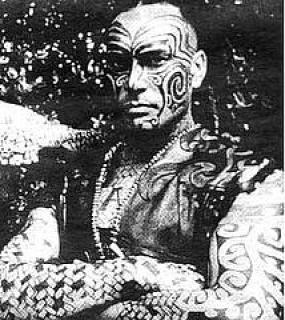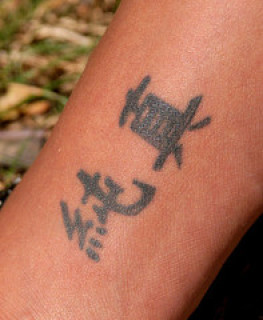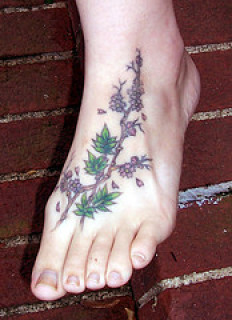| A tattoo is a permanent marking made by inserting ink into the layers of skin to change the pigment for decorative or other reasons. Tattoos on humans are a type of decorative body modification, while tattoos on animals are most commonly used for identification or branding. |

Body piercing and tattoos are a popular form of body art that have been practiced throughout history by various cultures. Various cultures have embraced adorning their bodies with piercings and tattoos throughout history.
In today's industrialized cultures, tattoos and piercing are a popular art form shared by people of all ages.
The word tattoo is derived from the Polynesian word 'ta' meaning 'to strike something' and the Tahitian word 'tatau' meaning 'to mark something'. Tattoo art history dates back to over 5000 years ago and is as various as the cultures and people that sport them. Tattoos to this day are increasingly popular, and are created by inserting coloring beneath the surface of the skin. One of the oldest known examples of tattoo art was found in 1991 on a 5000 year old ice man found in the mountains between Austria and Italy. This 'ice man' is the best preserved corpse ever found by archeologists and the skin of the ice man yielded more than 57 tattoos.
Tattooing is known to man for thousands of years. Different regions have their own purpose of tattooing. In some areas they tattoo their bodies as a part of tradition whereas in some regions people go for tattooing for cosmetic, religious, medicinal purposes. But most of the people sport tattoos to make style statements and express themselves and their personalities.
In some regions like the South East Asia and South Pacific, tattooing is done for health purposes as well. Health tattoos are common in Tibet, where people tattoo their bodies with sacred mantras, mantra wheels and mantra flags. The Tibetans believe that tattoos help the tattoo wearer to achieve inner as well as outer balance and harmony. It is interesting to note that the Tibetans also tattoo on certain acupuncture points and mix certain medicinal herbs in the dyes, to acquire certain medical effects.
Many cultures regard tattoos as protective amulets, and such magical applications are closely linked to religious beliefs. Ainu women in Japan, for instance, tattoo themselves with images of their Goddess, which is able to repel evil spirits and thus protect from disease. Iraqis commonly tattoo a dot at the end of a child's nose to guard against illness.
Pazyryks culture

The Pazyryks were formidable iron age horsemen and warriors who inhabited the steppes of Eastern Europe and Western Asia from the sixth through the second centuries BC. They left no written records, but Pazyryk artifacts are distinguished by a sophisticated level of artistry and craftsmanship. The Pazyryk tombs discovered by Rudenko were in an almost perfect state of preservation. They contained skeletons and intact bodies of horses and embalmed humans, together with a wealth of artifacts including saddles, riding gear, a carriage, rugs, clothing, jewelry, musical instruments, amulets, tools, and, interestingly, hash pipes, described by Rudenko as "apparatus for inhaling hemp smoke".
Egypt
Female mummy displayed several lines and dots tattooed about her body - grouping dots and/or dashes were aligned into abstract geometric patterns. this art form was restricted to women only, and usually these women were associated with ritualistic practice.
Japan
As the power of the common people and working classes of Japan grew in the latter half of the Edo period (circa 18th century) horimono, or traditional Japaneese tattoos, began to flourish as art form.

China
Tattoo is called "Wen Shen" or "Ci Shen" in Chinese. The term means literally "puncture the body". tattoo has been known and practised in China for many years. But it was never considered to be something artistic, desirable, or even acceptable. A commonly held notion is that one's body is a precious gift from the parent and therefore should never be abused or defaced by a tattoo.

Africa
Body decoration has a very long and strong tradition for the African people dating back almost 6000 years to the pharaohs of egypt and many of the body painting and tatauing rituals have still survived over the centuries. On the one hand it survived in some regions because the natives were, and still are, making their living serving tourists as photo models.
India
The Indian culture tattoo is penetrated by clerical symbolism. Colors, numbers and designed or from nature adapted shapes are used for cultural coherence same as for banal symbols. Scientists have observed the higher caste the and social position of the women the smaller and canny are the designs. symbols. Scientists have observed the higher caste the and social position of the women the smaller and canny are the designs.

Heath Risks
Since tattoos involve needles and blood, they carry several risks. These include transmission of diseases like hepatitis, tuberculosis and possibly HIV. When tattoo artists follow all the correct sterilization and sanitation procedures, risks for disease transmission are relatively low.
References:(answer.com, Wikipedia, arthistory.com, crystallinks.com, keibunsha.com, tattoojoy.com, .howstuffworks.com /) Images: VirtualAis…, dadawan, cwalker, cwalker71, reynardkarman
